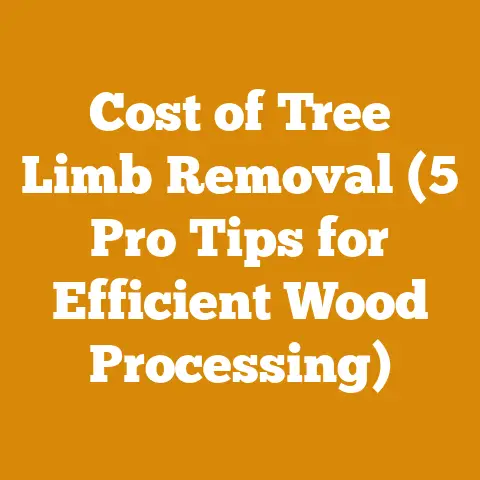Landscape Shrub Removal Tips (5 Pro Logging Hacks)
I once made a colossal blunder when I decided to clear a sprawling patch of overgrown shrubs from my property. Thinking I could handle it myself to save a few bucks, I charged in with a dull chainsaw and a whole lot of enthusiasm. The result? A backache that lasted a week, a chainsaw that needed serious repairs, and a shrub removal job that was only half-finished. That experience taught me a valuable lesson: proper planning, the right tools, and a solid understanding of the costs involved are crucial for any landscaping or wood processing project.
Let’s dive into the world of landscape shrub removal, focusing on how to tackle these projects efficiently and affordably. We’ll explore some pro logging hacks adapted for smaller-scale shrub clearing, and I’ll share my insights on budgeting and cost management to help you avoid the pitfalls I encountered. This isn’t just about hacking away at bushes; it’s about strategic removal, responsible disposal, and ultimately, saving yourself time, money, and a world of frustration.
Landscape Shrub Removal Tips (5 Pro Logging Hacks)
Understanding the Scope of the Project
Before you even think about firing up a chainsaw, it’s vital to assess the scope of your shrub removal project. This initial assessment will heavily influence the tools you need, the labor involved, and ultimately, the overall cost.
- Shrub Size and Type: Are we talking about a few small, manageable bushes, or a dense thicket of overgrown shrubs with thick trunks? The size and type of shrub will dictate the size and type of tools you need. For instance, removing thorny bushes like hawthorn will require heavy-duty gloves and protective clothing, adding to your personal protection equipment (PPE) costs.
- Root System: Some shrubs have shallow, easily removed root systems, while others have deep, extensive roots that require specialized tools like a stump grinder. Understanding the root system is crucial for accurate cost estimation.
- Accessibility: How easy is it to access the shrubs? Are they located in an open area or a tight, confined space? Limited access can increase labor costs and necessitate the use of smaller, more maneuverable equipment.
- Disposal Methods: How will you dispose of the removed shrubs? Will you chip them, burn them (if permitted), or haul them away to a landfill? Disposal costs can vary significantly depending on your chosen method.
- Permits: Depending on your location and the scale of the project, you might need permits for tree or shrub removal. Always check with your local authorities to avoid fines and delays. Permit costs can range from a few dollars to hundreds, depending on the regulations in your area.
Hack #1: Strategic Planning and Pre-Cutting
This is where I wish I had started. Instead of just blindly hacking away, take the time to develop a strategic plan. This involves:
- Clearing a Work Area: Remove any obstacles around the shrubs, such as rocks, branches, or debris. This will improve safety and efficiency.
- Pruning Branches: Before attempting to remove the entire shrub, prune away any overhanging branches. This will make it easier to access the base of the shrub and reduce the risk of branches getting caught in your equipment. I often use loppers or a pruning saw for this. A good pair of loppers can cost anywhere from $30 to $100, depending on the quality and brand.
- Cutting the Main Stem: Use a chainsaw or hand saw to cut the main stem of the shrub as close to the ground as possible. For larger shrubs, you may need to make multiple cuts.
- Safety First: Always wear appropriate PPE, including safety glasses, gloves, hearing protection, and sturdy boots. Chainsaws can be dangerous, so take your time and be careful.
Cost Implications: Strategic planning might seem time-consuming, but it can save you money in the long run. By pre-cutting branches and clearing a work area, you’ll reduce the risk of accidents, equipment damage, and wasted time.
Hack #2: Chainsaw Selection and Maintenance
Choosing the right chainsaw is crucial for efficient shrub removal. A small, lightweight chainsaw is ideal for smaller shrubs, while a larger, more powerful chainsaw is needed for thicker shrubs and tree-like bushes.
- Chainsaw Size: Consider the size of the shrubs you’ll be removing. A 14-16 inch chainsaw is generally sufficient for most residential shrub removal projects.
- Chainsaw Type: Gas-powered chainsaws are more powerful and versatile than electric chainsaws, but they also require more maintenance. Electric chainsaws are quieter and easier to start, but they may not be powerful enough for larger shrubs. Battery-powered chainsaws are becoming increasingly popular, offering a good balance of power and convenience.
- Chainsaw Maintenance: Regular chainsaw maintenance is essential for safety and performance. This includes sharpening the chain, cleaning the air filter, and checking the oil level. A dull chain can be dangerous and inefficient, so sharpen it regularly. I use a chainsaw sharpening kit that cost me around $30, and it’s paid for itself many times over.
Cost Implications: The cost of a chainsaw can range from $100 for a basic electric model to $1,000 or more for a professional-grade gas-powered chainsaw. Factor in the cost of maintenance, including chain sharpening, oil, and fuel. A well-maintained chainsaw will last longer and perform better, saving you money in the long run.
Data Point: According to a survey by Arbor Age magazine, the average lifespan of a chainsaw used by professional arborists is 5-7 years, assuming proper maintenance.
Hack #3: Leverage Specialized Tools
While a chainsaw is essential for cutting the main stem of the shrub, other tools can make the job easier and more efficient.
- Loppers: Loppers are ideal for cutting smaller branches and stems. They provide more leverage than pruning shears, making it easier to cut through thicker branches.
- Pruning Saw: A pruning saw is useful for cutting branches that are too thick for loppers but too small for a chainsaw.
- Shovels and Picks: Shovels and picks are essential for digging around the base of the shrub and removing the root system.
- Mattock: A mattock is a versatile tool that can be used for digging, chopping, and prying. It’s particularly useful for removing stubborn roots.
- Stump Grinder: For larger shrubs with extensive root systems, a stump grinder may be necessary. Stump grinders can be rented from most equipment rental companies. Rental costs typically range from $100 to $300 per day, depending on the size and power of the grinder.
Cost Implications: Investing in a few specialized tools can significantly improve your efficiency and reduce the amount of time and effort required to remove shrubs. While renting a stump grinder can be expensive, it may be the most cost-effective option for removing large, stubborn stumps.
Personal Story: I once tried to remove a large rhododendron stump with just a shovel and a pickaxe. After hours of back-breaking work, I barely made a dent. I finally gave in and rented a stump grinder, and the stump was gone in less than an hour. Lesson learned!
Hack #4: Efficient Root Removal Techniques
Removing the root system is often the most challenging part of shrub removal. Here are a few techniques to make the job easier:
- Expose the Roots: Use a shovel or pick to carefully expose the roots around the base of the shrub.
- Cut the Roots: Use a pruning saw or axe to cut the larger roots.
- Leverage the Stump: Use a pry bar or a long piece of wood to lever the stump out of the ground.
- Water Jetting: For clay soils, water jetting can be an effective way to loosen the soil around the roots. This involves using a high-pressure water hose to blast away the soil.
- Chemical Root Killers: Chemical root killers can be used to kill the roots of the shrub. However, these chemicals can also harm other plants in the area, so use them with caution. I generally avoid these unless absolutely necessary.
Cost Implications: Efficient root removal techniques can save you time and effort, reducing the overall cost of the project. If you’re hiring a professional, the cost of root removal will depend on the size and complexity of the root system.
Data Point: According to Landscape Management magazine, the average cost of stump removal by a professional is $2 to $5 per diameter inch.
Hack #5: Responsible Disposal and Recycling
Once you’ve removed the shrubs, you need to dispose of them responsibly. Here are a few options:
- Chipping: Chipping the shrubs is a great way to recycle them and create mulch for your garden. You can rent a wood chipper from most equipment rental companies. Rental costs typically range from $75 to $200 per day.
- Burning: Burning the shrubs may be an option in some areas, but check with your local authorities first. Burning can be a cost-effective way to dispose of large quantities of brush, but it can also be dangerous and polluting.
- Landfill: Hauling the shrubs to a landfill is the least environmentally friendly option, but it may be necessary if you don’t have access to a wood chipper or if burning is not permitted. Landfill fees vary depending on the location and the amount of waste.
- Composting: Smaller branches and leaves can be composted in your backyard.
Cost Implications: Disposal costs can vary significantly depending on your chosen method. Chipping is generally the most cost-effective and environmentally friendly option. Landfill fees can be expensive, especially for large quantities of waste.
Personal Story: I once rented a wood chipper and spent a weekend chipping all the brush from my shrub removal project. I ended up with a huge pile of mulch that I used to improve the soil in my garden. It was a win-win situation!
Detailed Cost Breakdown for Landscape Shrub Removal
Now, let’s get down to the nitty-gritty of costs. As I learned the hard way, underestimating the costs involved in a landscaping project is a recipe for financial headaches.
Material Costs
- Chainsaw: As mentioned earlier, the cost of a chainsaw can range from $100 to $1,000 or more. A decent mid-range chainsaw suitable for most residential shrub removal projects will cost around $300 to $500.
- Safety Gear: Safety glasses, gloves, hearing protection, and sturdy boots are essential for protecting yourself from injury. A good set of safety gear will cost around $50 to $100.
- Fuel and Oil: Gas-powered chainsaws require fuel and oil. A gallon of fuel typically costs around $4, and a quart of chainsaw oil costs around $10.
- Chain Sharpening: Chainsaw chains need to be sharpened regularly. You can either sharpen the chain yourself using a sharpening kit or take it to a professional. A sharpening kit costs around $30, while professional sharpening typically costs around $10 to $20 per chain.
- Other Tools: Loppers, pruning saw, shovels, picks, and other hand tools can cost anywhere from $50 to $200, depending on the quality and quantity of tools.
- Root Killer (Optional): If you’re using chemical root killers, the cost will depend on the type and quantity of chemical. A small bottle of root killer typically costs around $10 to $20.
Example: For a medium-sized shrub removal project, your material costs might look like this:
- Chainsaw (if you don’t already own one): $400
- Safety Gear: $75
- Fuel and Oil: $20
- Chain Sharpening: $15
- Other Tools: $100
- Total Material Costs: $610
Labor Costs
If you’re hiring a professional to remove the shrubs, labor costs will be a significant factor. Labor costs can vary depending on the location, the size and complexity of the project, and the experience of the contractor.
- Hourly Rate: Landscaping contractors typically charge an hourly rate of $50 to $100 per hour.
- Project-Based Pricing: Some contractors may offer project-based pricing, which is a fixed price for the entire project. This can be a good option if you want to know the exact cost upfront.
- Hidden Costs: Be sure to ask about any hidden costs, such as travel time, disposal fees, or permit fees.
Example: For a medium-sized shrub removal project, a contractor might charge $500 to $1,000 for labor.
Data Point: According to HomeAdvisor, the national average cost of shrub removal is $300 to $800, including labor and disposal.
Disposal Costs
Disposal costs can vary significantly depending on your chosen method.
- Chipping: Renting a wood chipper typically costs around $75 to $200 per day.
- Burning: Burning may be free, but it can also be expensive if you need to obtain a permit or if you’re fined for violating local regulations.
- Landfill: Landfill fees typically range from $50 to $100 per ton.
- Composting: Composting is generally free, but it requires time and effort.
Example: For a medium-sized shrub removal project, your disposal costs might look like this:
- Wood Chipper Rental: $100
- Total Disposal Costs: $100
Total Project Cost
To calculate the total project cost, add up the material costs, labor costs (if applicable), and disposal costs.
Example: For a medium-sized shrub removal project that you do yourself, the total cost might look like this:
- Material Costs: $610
- Labor Costs: $0 (since you’re doing it yourself)
- Disposal Costs: $100
- Total Project Cost: $710
If you hire a contractor, the total cost might look like this:
- Material Costs: Included in contractor’s fee
- Labor Costs: $750
- Disposal Costs: Included in contractor’s fee
- Total Project Cost: $750
Cost Optimization and Budget Management Tips
Here are a few tips to help you optimize your costs and manage your budget:
- Get Multiple Quotes: If you’re hiring a contractor, get quotes from multiple companies to compare prices.
- Do it Yourself: If you’re comfortable doing the work yourself, you can save a significant amount of money on labor costs.
- Rent Equipment: Renting equipment, such as a wood chipper or stump grinder, can be more cost-effective than buying it.
- Recycle Materials: Recycle the shrubs by chipping them and using them as mulch in your garden.
- Plan Ahead: Plan your project carefully to avoid unexpected costs.
- Be Flexible: Be prepared to adjust your budget if unexpected costs arise.
Calculations and Formulas
Here are a few relevant calculations and formulas that may be helpful:
- Estimating the Volume of Brush: To estimate the volume of brush, multiply the length, width, and height of the brush pile. These challenges include:
- Limited Access to Capital: Small-scale operators often have limited access to capital, making it difficult to invest in new equipment or technology.
- Fluctuating Timber Prices: Timber prices can fluctuate significantly, making it difficult to predict revenue.
- High Transportation Costs: Transportation costs can be a significant expense, especially for operators who are located far from markets.
- Regulatory Compliance: Regulatory compliance can be costly and time-consuming.
- Competition: Small-scale operators often face stiff competition from larger companies.
To overcome these challenges, small-scale loggers and firewood suppliers need to:
- Develop a Solid Business Plan: A solid business plan can help them secure funding and manage their finances.
- Diversify Their Revenue Streams: Diversifying their revenue streams can help them mitigate the risk of fluctuating timber prices.
- Invest in Efficient Equipment: Investing in efficient equipment can help them reduce their operating costs.
- Network with Other Operators: Networking with other operators can help them share resources and knowledge.
- Stay Up-to-Date on Regulations: Staying up-to-date on regulations can help them avoid costly fines and penalties.
Actionable Takeaways and Next Steps
So, you’re ready to tackle that shrub removal project? Here’s what you should do next:
- Assess the Scope: Carefully evaluate the shrubs you need to remove, considering their size, type, root system, and accessibility.
- Develop a Plan: Create a detailed plan that outlines the steps you’ll take, the tools you’ll need, and the disposal method you’ll use.
- Gather Your Tools: Make sure you have all the necessary tools and equipment, including a chainsaw, safety gear, loppers, pruning saw, shovels, and picks.
- Get Quotes: If you’re hiring a contractor, get quotes from multiple companies to compare prices.
- Set a Budget: Create a detailed budget that includes all the expected costs, such as materials, labor, disposal, and permits.
- Start the Project: Once you have a plan and a budget in place, you can start the project.
- Stay Safe: Always wear appropriate PPE and follow safety guidelines when using power tools.
- Dispose Responsibly: Dispose of the shrubs responsibly by chipping them, burning them (if permitted), or hauling them to a landfill.
- Evaluate Your Results: After the project is complete, evaluate your results and identify any areas where you could improve in the future.
By following these tips, you can tackle your landscape shrub removal project efficiently, safely, and affordably. Remember, proper planning and preparation are key to success!
Conclusion: From Overgrown to Opportunity
Removing unwanted shrubs is more than just a chore; it’s an opportunity to reclaim your landscape, enhance your property value, and even learn a new skill. By applying these pro logging hacks and carefully managing your costs, you can transform an overgrown eyesore into a beautiful and functional space.
Don’t make the same mistake I did by jumping in without a plan. Take the time to assess your project, gather the right tools, and develop a budget. With a little planning and effort, you can achieve professional-looking results without breaking the bank.
Remember, the satisfaction of a job well done, combined with the money you save by doing it yourself, is a reward in itself. So, grab your chainsaw, put on your safety gear, and get ready to transform your landscape! Good luck, and happy shrub removal!






